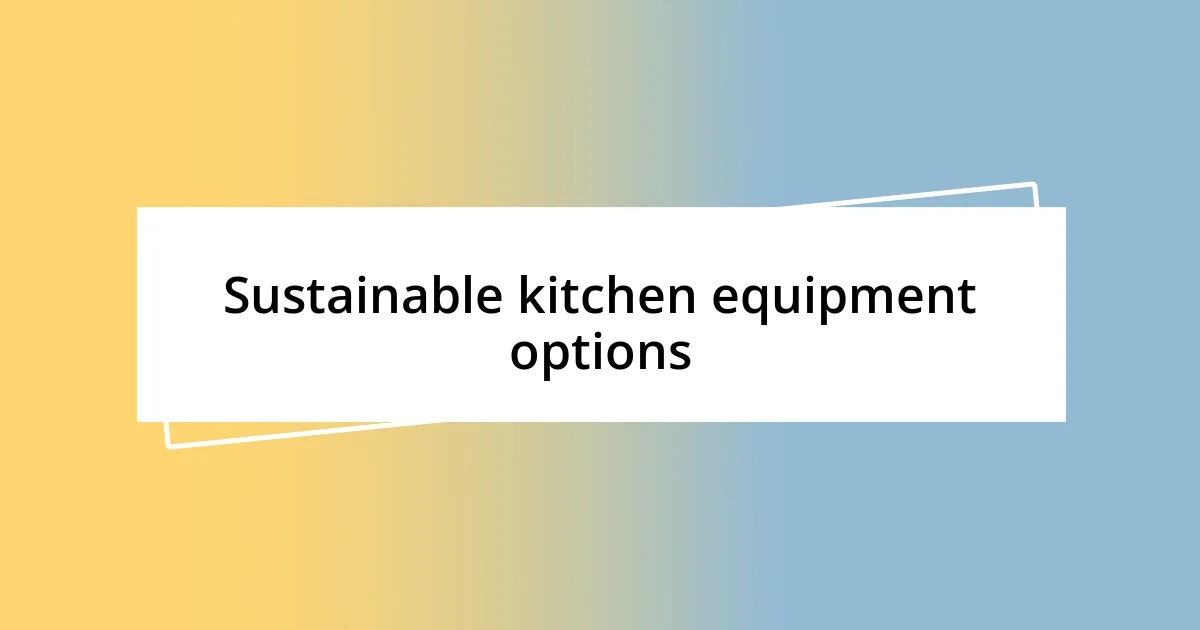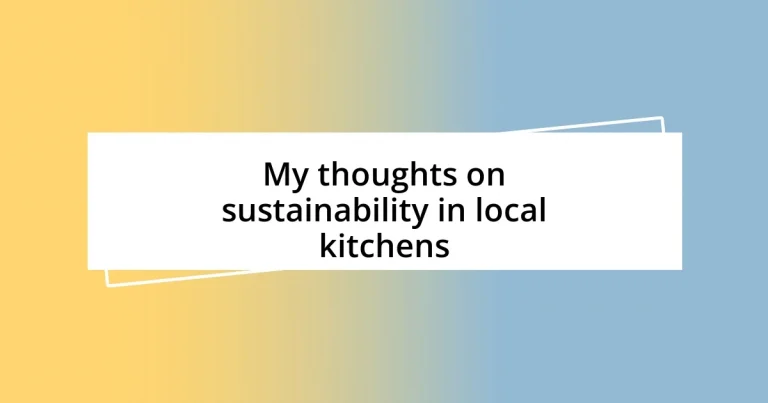Key takeaways:
- Sustainability in cooking involves understanding consumption’s impact on the environment, utilizing concepts like “reduce, reuse, recycle.”
- Supporting local and seasonal ingredients enhances food freshness, strengthens community ties, and encourages healthier eating habits.
- Engaging the community through workshops and shared experiences fosters collaboration and deepens connections around sustainable practices.

Understanding sustainability concepts
Sustainability, at its core, is about understanding the balance between our consumption and the planet’s resources. I remember the first time I realized the impact my kitchen habits had on the environment—I was unpacking a butcher paper-wrapped package of locally sourced produce, and it hit me: every item I choose has a story. Have you ever stopped to think about where your food comes from and the journey it takes before reaching your plate?
When we talk about sustainability, it’s crucial to grasp concepts like “reduce, reuse, recycle.” This triad is more than just a catchy phrase; it’s a lifestyle I’ve integrated into my cooking routine. For instance, I’ve taken to repurposing vegetable scraps into rich broths rather than throwing them away. Have you tried giving leftovers a second life? It’s not only satisfying but aligns well with sustainable practices.
Furthermore, the idea of community-supported agriculture (CSA) has transformed my local kitchen experience. Supporting local farmers fosters a connection to the land and reduces the miles our food travels, which is something I genuinely cherish. I often ponder: How can we create a more resilient food system together? Engaging with local initiatives makes that possibility feel not just hopeful but achievable.

Benefits of sustainable local kitchens
One of the most immediate benefits of sustainable local kitchens is the enhancement of flavor and freshness in the food we enjoy. I still remember the amazing taste of a summer tomato sourced from a nearby farm compared to the grocery store’s offerings. The difference is night and day, with that locally sourced tomato bursting with flavor, as if it was picked just moments before finding its way to my plate. Not only does fresh produce elevate meals, but it also encourages healthier eating habits, which is a win-win.
When you support local kitchens, you also contribute to the local economy and build a sense of community. Here are some benefits I’ve noticed firsthand:
- Reduced Carbon Footprint: Local ingredients travel shorter distances, decreasing transportation emissions.
- Greater Nutritional Value: Fresh food retains more nutrients and flavor compared to produce that has undergone long transport.
- Stronger Community Ties: Knowing local farmers and suppliers leads to a rich sense of belonging and engagement in the community.
- Encouragement of Seasonal Eating: It prompts us to embrace seasonal foods, which can lead to exciting new recipes and flavors.
- Support of Biodiversity: By choosing local, we often support diverse farming practices rather than mass-produced monocultures.
These benefits resonate deeply with me—I feel not just nourished, but also connected to my surroundings, making every meal a celebration of both flavor and community.

Practices for reducing kitchen waste
Practices for reducing kitchen waste can seem daunting, but I’ve learned a few simple strategies that can make a big difference. One practice I swear by is meal planning. By mapping out meals for the week, I reduce impulse buys and ensure that perishable items are utilized before they spoil. It’s like a little puzzle I enjoy solving, figuring out how to make the most out of what I have. Have you ever calculated how much fresh produce you throw away? It can be alarming!
Another easy enhancement is composting. At first, I thought it would be a chore, but it quickly became second nature. I remember the first time I tossed my apple peels into the compost bin instead of the trash—I felt an indescribable sense of fulfillment. It’s amazing how just one simple habit can help transform kitchen waste into nutrient-rich soil. Have you considered giving composting a try? Not only do you reduce waste, but you also contribute positively to your garden, which rewards you with beautiful plants.
Lastly, I’ve adopted the practice of storing open packages in reusable containers. Ziploc bags tend to pile up in my cupboard, taking up unnecessary space. Switching to glass jars or eco-friendly storage solutions not only minimizes waste but also keeps my ingredients fresh for longer. It’s like tidying up my kitchen while also making it more sustainable! Have you experienced the joy of a well-organized kitchen? It can even inspire you to cook more often!
| Practice | Impact |
|---|---|
| Meal Planning | Minimizes impulse buys and reduces spoilage |
| Composting | Transforms organic waste into soil; decreases landfill waste |
| Using Reusable Containers | Reduces plastic waste and keeps food fresh |

Choosing local and seasonal ingredients
Choosing local and seasonal ingredients has truly transformed my culinary experience. I still remember a chilly autumn evening when I visited a nearby farmers’ market, captivated by the vibrant colors of seasonal produce. Those deep orange pumpkins? They didn’t just look good; they inspired a hearty soup that warmed my soul and became a family favorite. Isn’t it amazing how the source of our food can spark our creativity in the kitchen?
Embracing seasonal ingredients not only enhances flavor but also connects me with the rhythm of nature. Each season brings a new palette of flavors to explore, inviting me to experiment with recipes that I wouldn’t typically consider. Last spring, I discovered a newfound appreciation for asparagus, which I had previously overlooked. Once I tried it grilled with a touch of lemon, I was hooked. Have you ever tasted something so fresh that it completely changed your perspective on it? Those local flavors have a way of reminding me why I love cooking in the first place.
Additionally, choosing local ingredients often leads me to forge meaningful relationships with farmers and artisans in my community. I recall a heartfelt conversation with a farmer about their sustainable practices and how they meticulously care for their crops. Knowing the story behind my food has made every meal feel like a shared celebration. Don’t you think there’s something special about knowing who grows your ingredients? It deepens our connection to the land and the people who nourish us, enriching our dining experience beyond mere sustenance.

Eco-friendly cooking techniques
Cooking sustainably in our local kitchens can be surprisingly rewarding. One eco-friendly technique I’ve embraced is steaming vegetables instead of boiling them. I remember the first time I tried it; I was delighted to see how vibrant and flavorful my broccoli turned out. Steaming preserves not just the colors but also vital nutrients that boiling often washes away. Have you ever tasted steamed veggies done right? You might be surprised at how they can elevate your dish!
Another favorite of mine is using the oven’s residual heat. After baking, I often toss in a dish of seasoned veggies or a quick casserole and let them cook slowly as the oven cools down. I find it comforting that I’m using energy more efficiently, and every bite feels like a hearty hug. It’s amazing how little adjustments like this can transform your cooking routine without compromising flavor or fun—don’t you agree?
Additionally, I’ve taken a liking to incorporating one-pan meals into my cooking repertoire. Not only do they cut down on cleanup time, but they also allow the flavors to meld beautifully. I recall feeling incredibly satisfied after creating a delicious stir-fry with leftover grains and whatever veggies I had on hand—a spontaneous creation that turned out to be a family hit. Do you have a favorite one-pan dish that makes you feel accomplished? These techniques not only save energy but also inspire creativity in how we use our ingredients!

Sustainable kitchen equipment options
When it comes to sustainable kitchen equipment options, I’ve found that investing in high-quality, long-lasting tools makes all the difference. For instance, I decided to purchase a sturdy cast-iron skillet, and it has become my go-to cookware. The first time I seared a steak in it, the deep, rich flavor that emerged left me utterly impressed. Isn’t it fascinating how a single piece of cookware can elevate your meals while being environmentally friendly?
I’ve also embraced using bamboo utensils instead of plastic ones. Initially, I was skeptical; would they provide the same functionality? However, after using them for a few weeks, I found that not only are they lightweight and easy to clean, but they also add a warm, natural touch to my kitchen. Plus, there’s something gratifying about knowing I’m reducing my plastic use with each stir and serve. Have you considered how small changes in your kitchen tools can contribute to a larger environmental impact?
Another noteworthy option is to explore energy-efficient appliances. I switched to a convection oven, and it has exceeded my expectations! Not only does it cook food evenly, but it also uses less energy than traditional ovens. One memorable roast I prepared was so succulent that it had the whole family asking for seconds. Isn’t amazing how modern technology can enhance our culinary adventures while being gentle on the planet? Sustainable kitchen equipment truly allows us to cook with purpose and joy.

Engaging the community in practices
I’ve seen firsthand how involving the community in sustainable kitchen practices can lead to exciting collaborations. Last summer, I participated in a local potluck where everyone brought dishes made from seasonal ingredients. The atmosphere was electric as we shared recipes, tips, and stories about our culinary journeys. It struck me how food really has a unique way of bringing people together—have you ever had that experience?
Organizing workshops is another fantastic way to engage the community. I once hosted a class on preserving summer produce, and it was amazing to watch participants light up as they learned to can tomatoes or pickle cucumbers. There’s something profoundly satisfying about sharing knowledge and skills, don’t you think? Those moments of discovery, coupled with laughter and shared successes, created bonds that extended beyond the kitchen.
We can also harness the power of social media to further our community efforts. I’ve been part of a local group on platforms like Facebook, where we swap not just recipes but also surplus produce from our gardens. It’s heartwarming to see people come together to reduce waste while supporting each other. Have you ever thought about how digital connections can foster sustainability in your own neighborhood? It’s incredible how a simple post can spark a significant change in our collective behavior.














